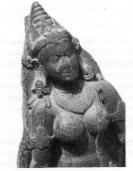World > India > Museums > The Assam State Museum
The Assam State Museum, Guwahati

This museum was founded in 1940 with a nucleus collection assembled by the Kamarupa Anusandhan Samiti (Assam Research Society). The museum's collection is largely archaeological, with sections devoted to epigraphy, numismatics and iconography. The sculptures from the Assam region fall into four principal categories - stone, wood, metal and terracotta. In ancient inscriptions of the Gupta period Assam was referred to as Kamarupa. Shiva is said to have carried the dead body of his wife sati and danced in range and sadness. Her body was scattered throughout the land by the force of the dance. Her yoni (female sexual organ) fell at the place where the Kamakhya Devi temple now stands, on a hill near Guwahati - the present capital of Assam, on the banks of the Brahmaputra.
Worship in this temple continues even today, with blood sacrifices of animals to appease Shakti, the powerful female principle. Apart from mother goddess worship, a strong Vaishnava cult also grew in Assam and many sculptures in the museum reflect the multiple strands of the culture of this region. The bust of the Devi (ninth century) and the figures of lovers in the Assam museum reflect one aspect of the tradition of shakti worship. The figures in sculpture carry marked Assamese features : high cheekbones and rounded faces, with long, often slanted, eyes.
With the conquest of Assam in 1288 by the Ahoms, a tribe of Thai origin, the influence of Indian art reached more distant regions, and in turn developed a new synthesis of cultures. The mighty Ahom rulers prevented the Mughals from conquering their territory and influencing their art. During British rule, like the rest of India, Assam came into administrative and cultural contact with Britain.
Timings : 10 am-4.30 pm except on Mondays and government holidays.


